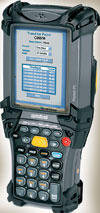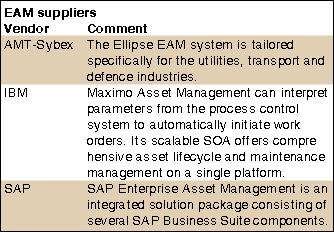
Fieldbus communications and the economic imperative of managing and maintaining productive assets efficiently and cost-effectively in this era of skills-shortages have been driving the development and implementation of asset management systems.
Imagine having to perform an inventory of all the instrument transmitters, actuators and final control elements installed at a process plant such as a refinery without the use of smart devices.
Today, the combination of suitable software and smart instrumentation with device integration interfaces which support protocols such as Hart, Profibus and Foundation Fieldbus make this achievable, with details of manufacture, model number, serial number, calibration data, status bits and more.
Realtime operating systems, high-speed networking and high-capacity hard disks allow systems to gather and store huge amounts of data from intelligent field devices on their own health and that of the connected processes and equipment. This data is stored in the historians of process control and scada systems.
Fast computer processors permit software to compare past and present data signatures of individual instruments, actuators, final control elements and complete loops and support the computation of complex process models for such loops. The software can use the incoming data to calculate overall equipment effectiveness (OEE) and make comparisons with other key performance indicators (KPIs).
Asset management systems combine these capabilities to offer human machine interface (HMI) configuration, device management, configuration and calibration, asset monitoring, optimisation and reporting. This presents new and more effective ways of managing production assets to reduce downtime and contain costs.
Asset management systems
Asset management systems are capable of managing parts of or the complete lifecycle pertaining to design, procurement, engineering, commissioning and maintenance.
There are two broad classifications of asset management systems: enterprise asset management (EAM) systems and plant asset management (PAM) systems. The former tend to be more biased toward treating instrumentation as financial assets while the latter are focused on the role and realtime performance of the instrumentation asset and associated plant in the production process.
ARC Advisory Group [1] describes PAM systems as a combination of hardware, software, and services deployed to help the workforce predict and assess the health of plant assets by monitoring asset condition periodically or in realtime to identify potential problems before they affect the process or lead to a catastrophic failure.

As well as condition monitoring and diagnostic alerts, a typical PAM system facilitates online and offline device configuration, parameter setting, tuning, calibration management and some level of works order management.

Where both EAM and PAM are deployed on a single site, the PAM typically performs signal analysis on collected data. When anomalies are detected it submits works order requests with relevant data to the EAM or computerised maintenance management system (CMMS) which then uses this as input to create the actual works order.

Whether performed by an EAM or PAM, automated work notification streamlines maintenance procedures and removes the need for manual works order creation. Repair time can also be reduced drastically because maintenance personnel are provided with detailed troubleshooting information, which includes probable causes and suggested remedial actions, directly from the work order.
IBM's Maximo and SAP's Plant Maintenance Module are examples of EAM systems. In the PAM field are products such as ABB's 800xA Asset Optimization PAM, Emerson's AMS Suite, Invensys' InFusion Condition Manager and Siemens' Simatic PCS 7 asset management.
Benefits
The benefits of employing an asset management system can be summarised as 'sweating the productive assets of a manufacturer' to gain a higher return on assets. They include the promise of fewer unscheduled stoppages, shorter response times, lower MTTR (mean time to repair), decreased maintenance costs and improved productivity, through their inherent diagnostic approach and the realtime monitoring and alarming of asset KPIs.
Employing an AMS can facilitate maintenance outsourcing or centralisation, which can alleviate the problems of skill shortages in a manufacturing facility, reduce training burden and reduce maintenance inventory holdings.
Another valuable benefit provided by AMS relates to the execution and recording of calibration activities in the regulated industries where compliance with certain procedures is mandatory.
Todd Gates, of Emerson Process Management tells [2] of one pharmaceutical company which calibrates 8000 devices per year saving an estimated US$264 000 per year in reduced calibration time. He attributed these savings to the following:
* The test scheme for each instrument resides in a database and downloads directly into a self-documenting calibrator.
* The use of route-based maintenance to calibrate instruments most efficiently.
* Automatically achieving regulatory compliance (Food and Drug Administration regulation, 21 CFR Part 11) for maintenance and calibration documentation.
System architectures
There is a wide variety of system architectures offered. Some vendors' systems are not integrated within the process control system, some are partially integrated, but have different HMI software and separate databases, while others like that in the new Yokogawa Centum VP are fully integrated within both the HMI and realtime database of the system.
Many of the systems on offer support e-mail messaging, remote analysis and diagnostics. For some multinational users that forms a mechanism for their organisation to centralise a team of skilled specialists who monitor and consult on asset performance at plants around the world. In some cases the vendors offer the services of support specialists who track equipment performance, deliver software upgrades, do maintenance checks, and carry out repairs.
Several vendors of asset management systems support 'point-of-work' initiatives, using mobile devices for works order confirmation, manual data input, calibration and maintenance functions on the plant floor and in the workshop.
Maintenance focus
In Keith Mobley's book on predictive maintenance [3] he says that maintenance costs can be between 15 and 60% of the cost of goods produced, depending on the industry. He also states that some one-third of all maintenance expenditure is wasted because of poor or unnecessary maintenance. When he wrote this book in 2002 he estimated this to translate to a loss of more than US$60 bn per year in the United States.
With these kinds of numbers it is not surprising that a common thread in both EAM and PAM is the maintenance of assets, with its massive potential for cost savings.
The thrust of this maintenance focus is the early identification of faults and the suggestion of probable causes and corrective actions before devices fail and cause unscheduled plant stoppages. Faults may be process discrepancies, or may be related to problems like vibration or lubrication failure relating to rotating machinery.
Maintenance trends
AMS become facilitators for companies to move away from breakdown maintenance and preventive maintenance (where equipment is replaced regardless of its condition based on hours of operation or number of operating cycles) to predictive maintenance (where equipment is replaced when it shows signs of requiring replacement). Companies adopting this proactive condition-based paradigm save on both hardware costs and, perhaps more significantly, on skilled labour, since these resources can be directed to essential and productive tasks.
Many of the systems on offer support routine equipment servicing through preventive maintenance programmes where works orders are triggered on elapsed time, machine hours or user-defined parameters such as throughput, temperature or pressure. However, preventive maintenance is not the principal maintenance philosophy for AMS users.
Predictive maintenance is one step closer to the ideal since it schedules specific tasks when they are actually required by the equipment. This is achieved through the ongoing monitoring of the mechanical condition of machines and the operating efficiency of processes to uncover impending failures.
The vast quantities of data stored in the historians of PAM systems can be mined by reliability centred maintenance (RCM) analysis tools to perform in-depth failure analysis when things do go wrong.
AMS facilitate the adoption of total productive maintenance (TPM) which J Venkatesh describes as "…the medical science of machines" [4]. TPM is a multidiscipline collaborative approach to maintenance involving engineering, maintenance and operations personnel all working towards the goal of holding emergency and unscheduled maintenance to a minimum.
Trends in PAM
ARC Research Group [Ibid] reports that the market for PAM systems will reinvent itself for many years to come and that based on the number of asset classes left to be addressed, we are still in the early stages of the PAM product lifecycle.
Manufacturing enterprises and vendors are looking to mine the rich seams of data that lie between separate functions like instrumentation and control, maintenance and operations and to use the results to achieve strategic objectives through improved machine asset availability and utilisation.
About the author
Andrew Ashton has electrical, mechanical and business qualifications and has been active in automation and process control since the early 1980s. Since 1991 he has headed up a company that has developed formulation management systems for the food, pharmaceutical and chemical manufacturing industries and manufacturing solutions involving the integration of various communication technologies and databases. Developed systems address issues around traceability, systems integration, manufacturing efficiency and effectiveness. Andrew is feature editor for SA Instrumentation and Control and editor of Motion Control in Southern Africa.
References
1. ARC Advisory Group: Plant Asset Management: Five Year Market Analysis and Forecast through 2011.
2. Todd Gates: Document all maintenance activities: www.plantengineering.com/article/CA295368.html
3. R. Keith Mobley: An Introduction to Predictive Maintenance. Butterworth-Heinemann, 2002.
4. J. Venkatesh: An Introduction to Total Productive Maintenance (TPM): www.plant-maintenance.com/articles/tpm_intro.shtml
| Tel: | +27 11 543 5800 |
| Email: | [email protected] |
| www: | www.technews.co.za |
| Articles: | More information and articles about Technews Publishing (SA Instrumentation & Control) |

© Technews Publishing (Pty) Ltd | All Rights Reserved